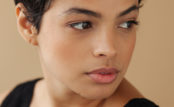 Alopecia is simply hair loss. You’ve heard of male pattern baldness – that’s androgenetic alopecia. But there are many forms of hair loss, among them involutional, areata and unversalis, all linked by the common thread of purging hair from the body.
Alopecia is simply hair loss. You’ve heard of male pattern baldness – that’s androgenetic alopecia. But there are many forms of hair loss, among them involutional, areata and unversalis, all linked by the common thread of purging hair from the body.
Don’t sweat too much about the odd hair remaining in your comb. Assuming you’re in good health, you’ve probably got between 100,000 and 150,000 hairs on your body. The average adult loses about 100 hairs each day. That’s not a concern, unless you’re losing hair faster.
Alopecia occurs for a variety of reasons. Most folks lose hair because it’s in their genes. However, other factors, including illness, stress and medication all have their say on your follicles – which produce the protein in hair called keratin responsible for hair growth. Depending on the kind of alopecia, hair might grow back when the cause is addressed.
Stages of Hair Growth
While roughly 90% of the hair on your scalp is growing at any one time, each follicle has its own life cycle. Broken down, this cycle has three phases:
Anagen – The growth phase. This lasts between two and six years.
Categen – Transitional hair growth, between two and three weeks.
Telogen – The resting phase, between roughly two and three months, at the end of which hair falls out and the cycle begins again.
Alopecia affects the life cycle of hair follicles, sometimes temporarily and at other times by killing them off. Forms of alopecia include:
Involutional Alopecia – This is a natural condition during which hair follicles go – and stay – in resting phase. The hair that remains becomes shorter and more sporadic.
Androgenetic alopecia – Also called androgenic alopecia, this is the dreaded male pattern baldness that affects roughly two-thirds of men. This process can begin in a man’s 20s or even teens and typically starts at the hairline and crown.
The female version of androgenetic alopecia tends to affect women later, usually in her 40s or beyond, and is usually a less noticeable broad thinning rather than the focussed hair loss that men experience.
Alopecia Areata – This occurs suddenly and causes patches of hair loss in children and young adults. Fortunately, this form of hair loss is usually reversible.
Alopecia Universalis – Less common than other forms of alopecia, this condition causes all body hair to fall out, including the eyebrows, eye lashes and pubic hair.
Causes of Alopecia
Hair follicles are a mysterious beast, with some having shorter lives than others for reasons we don’t always know. With that said, some factors appear to influence hair growth, or lack of it, including:
Hormones – High levels of male sex hormones appear to expedite the hair loss process. Dihydrotestosterone (DHT) is an aggressive form of testosterone believed responsible for much, if not most genetic hair loss in men.
 Genes – You’re more likely to lose strands if your relatives did. That’s both sides, by the way, not just from your maternal grandfather as you might have heard.
Genes – You’re more likely to lose strands if your relatives did. That’s both sides, by the way, not just from your maternal grandfather as you might have heard.
Stress, Illness and Childbirth – Each of these can cause temporary hair loss. A fungal infection, ringworm, can also make you lose hair.
Drugs – Ever seen the first season of Breaking Bad? Protagonist (though recently more of an anti-hero – to my other favoritie W.W.!) Walter White shaved his head in anticipation of chemotherapy and related medications. Blood thinners, beta-andrenergic blockers and birth control pills, among others, are all linked to hair loss in men and women.
Burns, Injuries and X-Rays – All of these pleansantries can lead to hair loss. Fortunately, in such cases it’s usually temporary.
Autoimmune Disease – A leading cause of alopecia areata, autoimmune disease attacks the immune system and for some reason affects the hair follicles. Most people with alopecia areata will grow their hair back, though it may be very fine and a lighter color at first.
Cosmetic Procedures – Hair treatments like perms, bleaching and coloring can make hair brittle and cause it to break off. Braids and tightly woven hairstyles can lead to hair loss as well. African American women appear to be at higher risk.
Medical Conditions – Some medical conditions, including thyroid disease, lupus, diabetes, iron deficiency and anemia can trigger hair loss, though it can usually be rectified with treatment of the underlying condition.
Diet – 97% of hair is protein, meaning that crash diets literally starve the body – and your scalp, of the building blocks for plentiful locks.
Treatment For Androgenic Alopecia
Treatment for hair loss varies according to the kind of alopecia. Any form of rapid hair loss should be diagnosed by a doctor, especially when in a young adult or child.
Medications for genetic hair loss can slow thinning and increase coverage with new growth and by enlargening the hair you’ve got, but they won’t grow back your mane of previous years. Hair loss medication designed for androgenetic alopecia should be taken on an ongoing basis too, or the new growth will fall out over the next six to 12 months.
Minoxidil (Rogaine) – Probably the best-known hair loss medication, Rogaine is a topical solution to be rubbed and/or sprayed on the scalp twice a day. Rogaine works best for frontal hair loss and has been studied primarily in men under 40. Curiously, it’s lethal to cats.
Finasteride (Propecia) – This is a prescription pill taken once a day. Unlike Rogaine, Propecia addresses the cause of androgenetic alopecia – excessive DHT levels. As well, it shows promising results, yet is linked to a series of sometimes permanent sexual side effects, including impotence. Propecia is not recommended for women, especially if they’re pregnant.
 ProFollica – A natural alternative to Rogaine and Propecia, ProFollica is a two or three part system with a supplement, an activator gel and optional shampoo. The formula reportedly helped 90% of men reduce hair loss in a clinical trial. Many guys are now turning to ProFollica over Rogaine and Propecia because it appears to be safer.
ProFollica – A natural alternative to Rogaine and Propecia, ProFollica is a two or three part system with a supplement, an activator gel and optional shampoo. The formula reportedly helped 90% of men reduce hair loss in a clinical trial. Many guys are now turning to ProFollica over Rogaine and Propecia because it appears to be safer.
Medications For Alopecia Areata
Treatments for alopecia areata include:
Corticosteroids – Injected into the scalp repeatedly about 1cm (0.4 inches) apart every four to six weeks, corticosteroids are the most common treatment for adults and are best used to address hair loss in patches.
Corticosteroid Ointments – Another option, you may have to use corticosteroid ointments with injected steroids or rogaine because they may not work alone.
Contact Immunotherapy – Perhaps the most effective treatment for severe areata. A common form of contact immunotherapy is called diphenylcyclopropenone (DPCP), which is ‘painted’ on the scalp once a week and with increasing strength. This treatment can irritate the skin, however, and is not widely available.
Psoralen With UltraViolet A Light – Psoralen is a medicine used to make the skin more sensitive to ultraviolet A (UVA) light.
Natural Help For Hair Loss
Not all guys want to go the medication route to fight hair loss. That’s understandable: in 2008 the Swedish Medical Product Agency released a warning that it couldn’t say that the sexual side effects linked to Propecia would not last even beyond discontinued use.
Assuming you’ve spoken with your doctor, and he’s ruled out any underlying medical condition of greater urgency, try these natural remedies for hair loss. While you won’t re-grow hair you’re genetically programmed to lose, they should at least minimize any further hair loss and feed your scalp hair-friendly nutrients like iron and vitamin B12.
Limit Meat Consumption – Japanese researchers link excessive sebum production to higher levels of the enzyme that converts testosterone to DHT, called 5-alpha-reductase. Their research suggests that animal fat may contribute to the process.
Try Saw Palmetto – A study published in the Journal of Alternative and Complimentary Medicine found that men who took 400 mg of a standard extract of saw palmetto, and 100 mg of beta-sitosterol (from saw palmetto) increased hair growth when taken each day.
Eat Sea Vegetables – Kelp, nori, dulse, kombu and wakame are all high in iodine and may be of interest to people with an underactive thyroid gland, which can lead to thinning hair. Speak with a qualified holistic healthcare professional for more information.
Consume Fatty Acids – Load up on walnuts, fish, flaxseed and avocado because they’re all high in essential fatty acids and are among the best foods that make hair grow. Food allergies permitting, of course.
Increase Biotin – One of the better nutrients for guys with hair loss, biotin encourages hair and scalp health. Find biotin in nuts, brown rice and oats. You can also get biotin, iron, and most other hair-friendly nutrients in this article from ProFollica.
 Eat B-Complex Vitamin Foods – Evidence suggests that 100mg of a B-complex supplement with biotin consumed daily can reduce thinning and encourage circulation to the scalp.
Eat B-Complex Vitamin Foods – Evidence suggests that 100mg of a B-complex supplement with biotin consumed daily can reduce thinning and encourage circulation to the scalp.
Opt For Iron-Rich Foods – Leeks, cashews, green leafy vegetables, dried fruits, eggs and berries all perform nicely in the iron department. That’s a good thing, made better when you accompany iron-rich foods with those high in vitamin C. Add red peppers, citrus fruits and strawberries to your plate and you’ve got the makings of a hair-growing diet.




